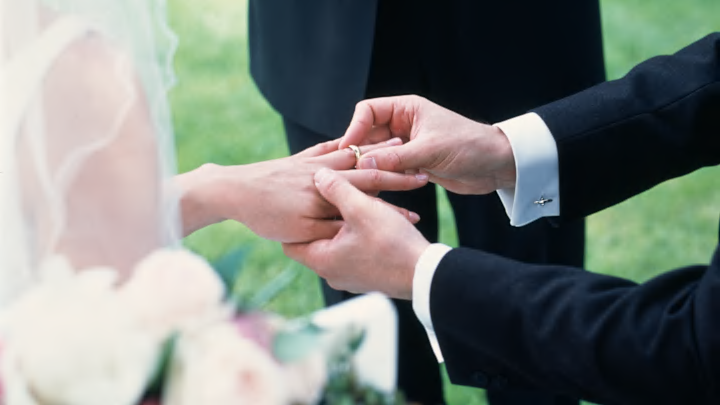For years, couples have dedicated a single “ring” finger to romance when any other digit would do. A case of left side, strong side? Not according to history.
In medieval times, getting caught scribbling with one’s left hand could earn accusations of being possessed and, during the Spanish Inquisition, lefties were more likely to be tortured or killed. In fact, the aversion touched many cultures, from the long-standing taboo in Islamic countries against eating and drinking with one’s left hand, to the expectation in ancient Japan that any wife who didn’t favor her right could be legally divorced on the spot, no questions asked. So why do we favor a finger on a cursed hand to symbolize lasting love?
Past perception wasn’t all bad. The union between marriage and the now-standard ring placement can be traced back to second-century Egyptians who falsely believed “a certain most delicate nerve” began in the fourth left finger and stretched directly to the heart, according to the Greek scholar Appian. Centuries later, the Romans came to a similar conclusion. In place of a nerve, they were convinced that a vena amoris—or “lover’s vein”—connected this digit with the blood-pumping organ.
During the Roman engagement process, a well-off suitor who could afford a ring would slip it over his bride-to-be’s fourth finger. Thus, he’d always have a symbolic grip around her lover’s vein. The modern world may have adopted that practice from the Romans.
Still, others argue that reverence for the fourth finger began as an early Christian ritual. While crossing themselves in an Orthodox Church, worshipers are expected to join the thumb with the index and middle fingers. Historians contend that the group represented the father, son, and Holy Ghost when placed together, while the “ring” finger signified earthly love, making it the perfect location for a spouse’s wedding ring.
Until the 17th century, Orthodox couples normally wore their rings on the right hand (an extremity that’s associated with strength) and most Europeans of all faiths followed suit. But during the Reformation in 1549, an English Bishop and Protestant reformer named Thomas Cranmer used wedding rings as a way to break from tradition. That year, he published The Book of Common Prayer, which instructs couples to ditch a centuries-old practice in favor of slipping their wedding rings over the left fourth finger. Before long, husbands and wives throughout the continent were doing so.
Read More About Wedding Traditions:
A version of this story originally ran in 2017; it has been updated for 2025.
